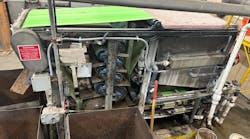When it comes to tanks at wastewater treatment plants that contain solids slurries—whether for anaerobic digestion or sludge storage—a key factor in proper system design, operation and maintenance is mixing. Anaerobic digesters routinely operate with solids concentrations in the range of 3% to 5%. Sludge storage tanks can have solids concentrations exceeding 5% dry solids and, in some extreme cases, settled solids at the bottom of these tanks can be as high as 10% to 12% dry solids. For applications in which the solids concentrations are elevated, special considerations must be taken when selecting a mixing system.
Mixing for such applications is not a new challenge; however, there have been a number of developments and improvements over the years. Commonly available mixing technologies for these types of tanks include mechanical mixers, gas mixing, draft tube mixing and hydraulic mixing. In recent years, advances in the design of hydraulic mixing systems have helped this technology become one of the leading mixing solutions today. A variety of hydraulic mixing systems are available on the market that use the general concept of having a pump recirculate flow from the tank through nozzles strategically located inside the tank. Properly designed systems provide effective mixing and help to improve anaerobic digester efficiency and the effective resuspension of solids in applications such as sludge storage tanks that are allowed to settle and sit idle for months at a time.
One of the primary reasons hydraulic mixing has evolved to become a preferred mixing solution is its ability to do an excellent job of addressing common issues and pitfalls that can arise in mixing digesters and sludge storage tanks. Tanks containing solids slurries, such as sludge storage tanks and digesters, are notorious for having fibrous materials reweave and create ragging issues in pumps and on impeller blades. Hydraulic mixing helps to overcome such issues, as well as dead spots in tanks where solids tend to accumulate, added tank and system maintenance, and control of scum and foam. These all can contribute to operational issues in the system, requiring additional labor to maintain the mixing system and to clean out the tank.
Proper System Design
A properly designed hydraulic mixing system, which is critical for these systems to work effectively, will address at least two key areas: nozzle design and pump selection.
Nozzle design, location and the number of nozzles greatly affect the efficiency of the system in terms of maintaining adequate mixing and suspension of solids, as well as in the total power required to mix the tank. Nozzle exit velocity and orientation relative to tank geometry also are critical. Provisions for allowing all or some of the nozzles to be rotatable can add to system flexibility, especially for tanks that are challenging to mix due to their configuration. Nozzles can be added above the water surface to help control and reduce foam and scum on the tank surface.
The type of pump used can greatly impact the effectiveness of the system. Use of heavy-duty chopper pumps designed for wastewater applications is critical to the system performance to cut up any rags or debris and prevent clogging in the system. Furthermore, the pump design must be coordinated with the nozzle design to ensure that desired mixing goals are achieved.
Success Story
In 2006, the Wheaton Sanitary District (WSD) installed the first of two JetMix hydraulic mixing systems from Siemens at its wastewater treatment plant in Wheaton, Ill. The district needed to replace its former gas mixing system quickly, as it was destroyed when the tank cover was being taken out of service. The new system was delivered within a month.
The 1,350-gal-per-minute hydraulic mixing system uses a 25-hp chopper pump to agitate sludge within the anaerobic digestion process, optimizing digestion and methane production. The system's design provides efficient mixing that keeps the tank floor clean and breaks up the scum layer at the top of the tank. The solids concentration is 4% to 5%.
In addition to the timely delivery and installation, the WSD decided on the JetMix hydraulic mixing system because it was sized most efficiently, with two patented nozzles and a 25-hp motor. The circular digestion tank easily resuspends settled solids when the system is turned on. Fully rotatable nozzles are available for sludge holding tanks or in digesters with columns that require moving the nozzle direction to clean areas where the normal mixing flow is obstructed.
The JetMix allows operators to schedule mixing times, which can reduce power usage by 60% to 80% without decreasing methane gas production or negatively affecting volatile solids reduction. The WSD reduced its energy usage by approximately 90%.
The system requires virtually no upkeep aside from typical pump maintenance. Thorough mixing action saves on tank cleaning and washdown costs. Unlike gas and mechanical mixing, all moving parts are outside the system where they are readily accessible. Since installing the new system, the WSD has noticed minimum scum blanket buildup, improved volatile solids destruction and better overall digestion.
The district has continued to optimize by consistently reducing the mixing period to a level at which it maintains anaerobic digestion performance by operating for a four-hour period one day per week. This has allowed the WSD to maintain excellent gas production with an average of 0.6 hp per day. The district uses the methane produced for heating digesters in the support buildings.
The WSD was so impressed with the JetMix system's performance that in 2008 it installed a second one on its other primary digester.
Leading Mixing Solution
Hydraulic mixing is especially ideal for mixing tanks such as digesters and sludge storage tanks in which solids concentrations exceed 4% to 5% solids. The hydraulic mixing system at Wheaton's wastewater treatment plant is one of hundreds that are already installed and operational worldwide. More facilities with mixing challenges are expected to turn to hydraulic mixing in the future for its flexibility, performance and low maintenance requirements.
Download: Here

